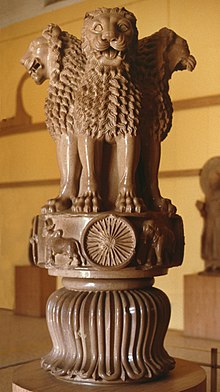Sarnath Museum

Ashoka pillar capital of Sarnath.
|
|
| Established | 1910 |
|---|---|
| Location | Saranath (near Varanasi) |
| Type | Archaeological museum |
| Collection size | Buddhist art, sculpture, antiquities |
Sarnath Museum is the oldest site museum of Archaeological Survey of India. It houses the findings and excavations at the archaeological site of Sarnath, by the Archaeological Survey of India. Sarnath is located near Varanasi, in the state of Uttar Pradesh. The museum has 6,832 sculptures and artefacts.
To keep the antiquities found from the site, a decision was taken in 1904 by the Government to construct a site museum adjacent to the excavated site at Sarnath. It was due to initiative of Sir John Marshall, the then Director General of Archaeology in India, that this museum was created. The plans were prepared by Mr. James Ramson, the then consulting Architect to the Government of India. The building was completed in 1910 to house, display and study the antiquities in their right perspective. The building forms half of a monastery (Sangharam) in plan.
The museum contains five galleries and two verandahs to display the antiquities ranging from the 3rd century BCE to 12th century AD that have been found at Sarnath.
Sarnath has yielded a rich collection of sculptures, artefacts and edifices comprising numerous Buddha and Bodhisattva images and other ancient remains. Finest specimens of Buddhist art and other important remains have been housed at the museum.
While the single most famous exhibit of this museum is the Lion Capital of Ashoka, the Sarnath museum also houses a collection of other Buddhist artefacts. Among the things to see is a sculpture of the Buddha from the 5th century. The Buddha sits cross-legged, with eyes downcast in deep meditation, and a halo around his head. Also worth exploring are the several figures of the bodhisattvas.
Of other Buddhist remains, there is a life-size standing Bodhisattva and a delicate image of the Bodhisattva with a lotus and yet another bronze sculpture showing the Bodhisattva with multiple arms. The museum at Sarnath also houses a collection of figures and sculptures from the Mauryan, the Kushana and the Gupta periods. Prominent among them is the earliest Buddha image found at Sarnath and many images of Hindu Gods dating from the 9th to 12th centuries.
...
Wikipedia
